专业英语命名法
专业英语命名法 3
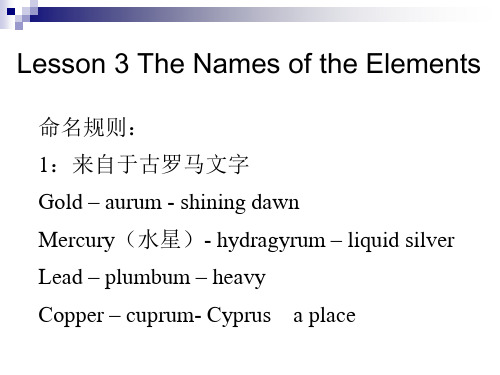
2. 俗名 (Common Name)
Compounds
NaOH Na2CO3
IUPAC Name
Sodium Hydroxide Sodium Carbonate sodium hydrosulfite potassium nitrate
Common name
Caustic Soda Soda
Na2S2O4
Lesson 3 The Names of the Elements
命名规则: 1:来自于古罗马文字 Gold – aurum - shining dawn Mercury(水星)- hydragyrum – liquid silver Lead – plumbum – heavy Copper – cuprum- Cyprus a place
* 如果某元素能形成一种以上的阳离子,则使用斯托克 数字(Stock number)来表示其所带电荷(只形成 一种阳离子的不必用). 例:NaOH:sodium hydroxide; KOH:potassium hydroxide
18
5. Names of Salts(盐的命名):
不带“ion”的阳离子名称 + 不带“ion”的阴离子名称
1. 甲 : meth-; 2. 乙 : eth-; 4. 丁: buta-; 5. 戊: penta-; 7. 庚 : hepta-; 8. 辛 : octa-; 10. 癸 : deca-. 11. 半 , 1/2: 12. 单 , 一 : mono-, uni-; 13. 14. 双, 两: di-, bi-, bis-.
* 阳离子的电荷数用斯托克数字(Stock number) 来表示(只形成一种阳离子的元素不必用).
专业英语作业Nomenclature of Inorganic Chemistry
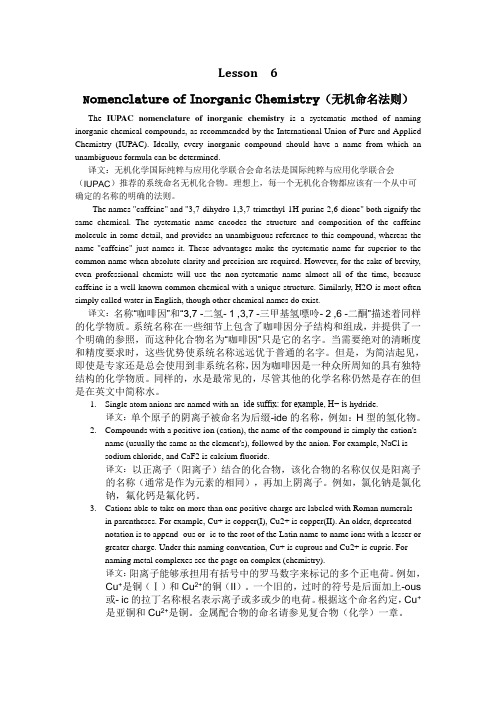
Lesson 6N omenclature of Inorganic Chemistry(无机命名法则)The IUPAC nomenclature of inorganic chemistry is a systematic method of naming inorganic chemical compounds, as recommended by the International Union of Pure and Applied Chemistry (IUPAC). Ideally, every inorganic compound should have a name from which an unambiguous formula can be determined.译文:无机化学国际纯粹与应用化学联合会命名法是国际纯粹与应用化学联合会(IUPAC)推荐的系统命名无机化合物。
理想上,每一个无机化合物都应该有一个从中可确定的名称的明确的法则。
The names "caffeine" and "3,7-dihydro-1,3,7-trimethyl-1H-purine-2,6-dione" both signify the same chemical. The systematic name encodes the structure and composition of the caffeine molecule in some detail, and provides an unambiguous reference to this compound, whereas the name "caffeine" just names it. These advantages make the systematic name far superior to the common name when absolute clarity and precision are required. However, for the sake of brevity, even professional chemists will use the non-systematic name almost all of the time, because caffeine is a well-known common chemical with a unique structure. Similarly, H2O is most often simply called water in English, though other chemical names do exist.译文:名称“咖啡因”和“3,7 -二氢- 1 ,3,7 -三甲基氢嘌呤- 2 ,6 -二酮”描述着同样的化学物质。
应用化学专业英语 -化合物命名
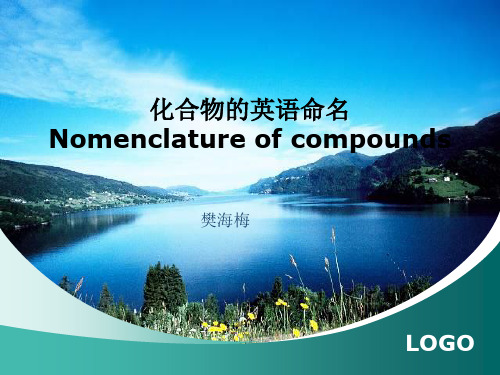
醇
酚类命名法
硫醇和硫酚
酮的命名法Biblioteka 根基命名法:醚类命名
羧酸命名
CH3-CH2-CH(CH3)-CH3 2-methylbutane
2,2-dimethylpropane CH3CH(CH3)-CH2-CH(C2H5)-CH(CH3)-CH2-CH3 4-ethyl-2,5-dimethylheptane
除了系统命名法,有一些支链烷烃是可以采用普 通命名法来命名的
化合物的英语命名 Nomenclature of compounds
樊海梅
LOGO
有机化合物的命名
链 烃
饱和烃:烷烃 不饱和烃:烯烃,炔烃 脂环烃 芳香烃
烃
有 机 物
环 烃
卤代烃
烃 的 衍 生 物
醇
含 氧 衍 生 物
酚 醛 酮 羧酸
酯等
烷烃(alkanes) 直链烷烃:英文名称除了含1到4个碳原子以外,其余均用希腊
90 alkane:nonacontane
100 alkane:hectane
含支链烷烃和烷基 烷基:只需要把烷烃的后缀ane换成-yl加在相应烷烃的字 首后 如:CH3- methyl CH3-CH2- ethyl CH3-(CH2)9-CH2 undecyl
还有一些烷基也可以在相应的烃名前加iso-(异)、sec-仲、tert-叔、
CH3CH2-C(CH3)2-CH3:
烯烃(alkene)和炔烃(alkynes):将相应的烷烃的词尾(ane)改为
ene和yne,名称前加上不饱和键的编号, 如:乙烯 ethene 丁烯 butene 乙炔 HC≡CH ethyne 丁二炔 HC ≡C-C ≡CH butadiyne
专业英语课件 ——化合物英文命名
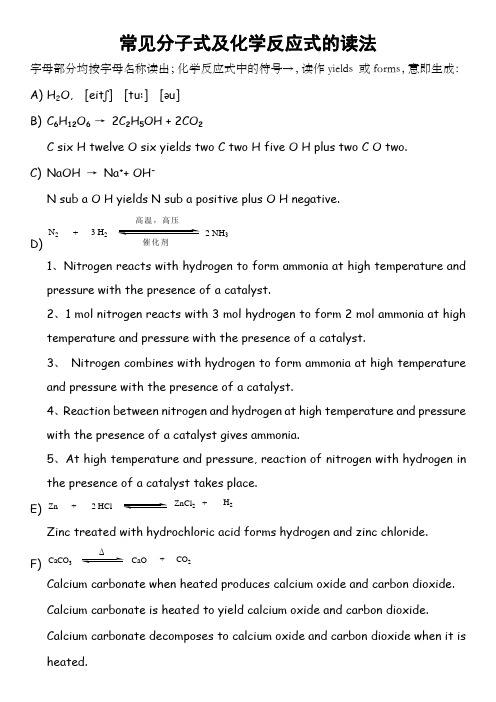
常见分子式及化学反应式的读法字母部分均按字母名称读出;化学反应式中的符号→,读作yields 或forms ,意即生成: A) H 2O, [eit ʃ] [tu:] [əu] B) C 6H 12O 6 → 2C 2H 5OH + 2CO 2C six H twelve O six yields two C two H five O H plus two C O two. C) NaOH → Na ++ OH -N sub a O H yields N sub a positive plus O H negative.D)1、Nitrogen reacts with hydrogen to form ammonia at high temperature and pressure with the presence of a catalyst.2、1 mol nitrogen reacts with 3 mol hydrogen to form 2 mol ammonia at high temperature and pressure with the presence of a catalyst.3、 Nitrogen combines with hydrogen to form ammonia at high temperature and pressure with the presence of a catalyst.4、Reaction between nitrogen and hydrogen at high temperature and pressure with the presence of a catalyst gives ammonia.5、At high temperature and pressure, reaction of nitrogen with hydrogen in the presence of a catalyst takes place. E)Zinc treated with hydrochloric acid forms hydrogen and zinc chloride. F)Calcium carbonate when heated produces calcium oxide and carbon dioxide. Calcium carbonate is heated to yield calcium oxide and carbon dioxide. Calcium carbonate decomposes to calcium oxide and carbon dioxide when it is heated.N 2+3 H 22 NH 3高温,高压催化剂Zn+2 HClZnCl 2+H 2CaCO 3CaO+CO 2Δ化合物命名1、无机物命名无机化合物英文名称的基本构词规律:◆在化合物命名时常用的英文数目词头:•mono-(1), ['mɒnəʊ]•di-(2), [dai]•tri-(3), [trai]•Tetra-(4), ['tetrə]•penta-(5), ['pentə]•hexa-(6),•hepta-(7),•Octa-(8),•nona-(9), ['nəunə]•deca-(10),•undeca-(11),•dodeca-(12)。
化学专业英语词汇常用前后缀&简单命名方法

-acetal 醛缩醇acetal- 乙酰acid 酸-al 醛alcohol 醇-aldehyde 醛alkali- 碱allyl 丙烯基alkoxy- 烷氧基-amide 酰胺amino- 氨基的-amidine 脒-amine 胺-ane 烷anhydride 酐anilino- 苯胺基aquo- 含水的-ase 酶-ate 含氧酸的盐、酯-atriyne 三炔azo- 偶氮benzene 苯bi- 在盐类前表示酸式盐bis- 双-borane 硼烷bromo- 溴butyl 丁基-carbinol 甲醇carbonyl 羰基-caboxylic acid 羧酸centi- 10-2chloro- 氯代cis- 顺式condensed 缩合的、冷凝的cyclo- 环deca- 十deci 10-1二-dine 啶dodeca- 十二-ene 烯epi- 表epoxy- 环氧-ester 酯-ether 醚ethoxy- 乙氧基ethyl 乙基fluoro- 氟代-form 仿-glycol 二醇hemi- 半hendeca- 十一hepta- 七heptadeca- 十七hexa- 六hexadeca- 十六-hydrin 醇hydro- 氢或水hydroxyl 羟基hypo- 低级的,次-ic 酸的,高价金属-ide 无氧酸的盐,酰替…胺,酐-il 偶酰-imine 亚胺iodo- 碘代iso- 异,等,同-ite 亚酸盐keto- 酮ketone 酮-lactone 内酯mega- 106meta- 间,偏methoxy- 甲氧基methyl 甲基micro- 10-6milli- 10-3mono- ( mon-) 一,单nano- 10-9nitro- 硝基nitroso- 亚硝基nona- 九nonadeca- 十九octa- 八octadeca- 十八-oic 酸的-ol 醇-one 酮ortho- 邻,正,原-ous 亚酸的,低价金属oxa- 氧杂-oxide 氧化合物-oxime 肟oxo- 酮oxy- 氧化-oyl 酰para- 对位,仲penta- 五pentadeca- 十五per- 高,过petro- 石油phenol 苯酚phenyl 苯基pico- 10-12poly- 聚,多quadri- 四quinque- 五semi- 半septi- 七sesqui 一个半sexi- 六sulfa- 磺胺sym- 对称syn- 顺式,同,共ter- 三tetra- 四tetradeca- 十四tetrakis- 四个thio- 硫代trans- 反式,超,跨tri- 三trideca- 十三tris- 三个undeca- 十一uni- 单,一unsym- 不对称的,偏位-yl 基-ylene 撑(二价基,价在不同原子上)-yne 炔AndrewSiyer:(by monopoly)简单有机物的命名就是主链词头比如propa-/buta-/penta-/hexa--ane/-ene/-yne,然后比如烯炔,1,3-dien-5-yne然后再加-ol/-amine/-al/-one/-oic acid通俗命名法里这些也是可以叠加的,比如phenyl propanol amine系统命名法里,除了主官能团以外的基团就得用取代基词头hydroxy-/amino-/formyl-/oxo- or keto-/carboxyl-。
化学专业英语化合物的命名

Cu2O: copper(I) oxide 或cuprous oxide
CuO: copper(II) oxide或cupric oxide
10
Naming nonmetal ions (anions)
1. Monatomic anions
Anion’s name = Element’s root -ide
for example:
H2CO3 Carbonic acid
H2SO4 Sulfuric acid
H3PO4 Phosphoric acid
HNO3 Nitric acid
HClO4 Perchloric acid
HCl
Hydrochloric acid
26
(2). Meta- and hypo-acid ( its salt-ite)
Common Transition Elememt
Fe : iron Mn : manganese Cu: copper Zn: zinc Hg: mercury Ag: silver Au: gold
6
2 化合物的命名
化合物的命名顺序都是根据化学式从左往右读, 这与中文读法顺序是相反的。表示原子个数时使用 前缀 (1)mono-,(2)di -,(3)tri- ,(4)tetra – ,(5)penta(6)hexa-,(7)hepta-, (8)octa-,(9)nona-,(10)deca-,但 是在不会引起歧义时,这些前缀都尽可能被省去。
For example:
Cl- Chloride
Br- Bromide I- Iodide S2- Sulfide
O2- Oxide
OH- Hydroxide CN- Cyanide H- Hydride
专业英语(无机化合物命名 )

(5) Acids derived from binary compounds 由二元化合物得到得酸 For binary compounds with hydrogen as the positive ion, place the term hydro at the front of the stem of the negative ion, the letter ic at the end of the stem, and add the word acid. 以H作为阳离子,在成酸元素之前加hydro, 成酸元素之后改 ic , 再加acid. Eg: HCl: hydrochloric acid H2S: hydrosulfuric adic
不同氧化度的二元化合物
- 过氧化物: peroxide [pəˈr ɔkˈsad] O22ɪ
H2O2: hydrogen peroxide •超氧化物: superoxide [ˈsju:p ˈ ə ɔksaid] O2-
KO2: Potassium superoxide
[pəˈtæsi əm]
(4) Exceptions that use the ide endings These polyatomic ions take the ending ide even though more than two elements are present: -Hydroxide (OH-) -Cyanides(CN-) ['saiənaid] -Ammonium (NH4+) Eg: NH4I : Ammonium iodide Ca(OH)2: Calcium hydroxide KCmon Transition Elememts
化妆品专业英语:有机物的命名

乙醇 己二醇 癸二醇 戊二醇 丙二醇 丁二醇 辛甘醇(1,2-辛二醇)
PART 3 [醚 (Ethers)]
CONTENT 1 [醚 (Ethers)]
规 律 烃1+烃2+ether,其中烃1和烃2按照字母顺序列出 若为两个复合基且相同,则前加数词“di”或“bis”
举例:
CH3OCH2CH3 CH3CH2OCH2CH3 CH3OCH3
丙三醇(甘油) 鲸蜡醇 硬脂醇 鲸蜡硬脂醇 山嵛醇 油醇 异硬脂醇 山梨(糖)醇 乙二醇 生育酚(维生素E) 薄荷醇
CONTENT 3 [醇和酚(Alcohols and Phenols )]
TASK
Ethanol Hexanediol Decanediol Pentylene glycol Butylene glycol Butylene glycol Caprylyl glycol
规 律 a. 将烃基名称的词尾“e”去掉,加上“ol”;或直接在烃基 后加
“alcohol(醇)/glycol(二醇)”
b. 多元醇和多元酚在烃名和“ol”间加di、tri等数词指出羟基个数
c. 羟基位于侧链时作为取代基处理,用hydroxyl-表示
举例:
苯酚 甲醇 二丙醇(异丙醇) 肉桂醇 苯乙醇 1,3-丙二醇 羟丙基纤维素
Ethyl methyl ether Diethyl ether Dimethyl ether Diphenyl ether
甲基乙基醚 乙醚 二甲醚 二苯醚
PART 4 [醛和酮
(Aldehydes and Ketones)]
CONTENT 1 [醛和酮 (Aldehydes and Ketones)]
烯烃和炔烃(alkenes and alkynes)
应用化学专业英语 -无机化学命名

(3) 基本元素有多种价态 酸:最低氧化态(次酸) 基础元素(前缀 hypo-, 后缀 -ous) +acid 较低氧化态(亚酸) 基础元素加后缀-ous + acid 较高氧化态 (正酸) 基础元素加后缀-ic + acid 最高氧化态(高酸) 基础元素(前缀 per-, 后缀 -ic) +acid 盐:最低氧化态 阳离子元素 + 基础元素(前缀 hypo-, 后缀 -ite) 较低氧化态 阳离子元素 + 基础元素加后缀-ite 较高氧化态 阳离子元素 + 基础元素加后缀-ate 最高氧化态 阳离子元素 + 基础元素(前缀 per-, 后缀 -ate)
16. K4[Fe(CN)6]; 17. CuSO4· 5H2O 18. Cu2(OH)2CO3 19. NaNH4SO4
1. (NH4)2CO3: ammonium carbonate 2. N2O: nitrogen(Ⅰ) oxide; nitrous oxide ; laughing gas 3. H2SO4: sulphuric acid 4. P4O6 diphosphorus trioxide 5. Al2O3 Aluminum oxide 6. SnCl4 tin(Ⅳ) chloride; stannic chloride; tin terachloride 7. KHSO4 Potassium hydrogen sulfate 8. Cu2S copper(I) sulphide; dicopper sulphide 9. HClO4 perchloric acid
含氧酸及其盐:
(1) 基本元素仅有一种氧化态
酸:基本元素加后缀-ic +acid 例:H2CO3 carbonic acid 盐:阳离子元素+基础元素加后缀-ate 例:Na2CO3 sodium carbonate (2) 基本元素有两种氧化态 酸:基础元素加后缀(-ous 低价态,-ic 高价态) + acid HNO2:nitrous acid HNO3: nitric acid 盐:阳离子元素+基础元素加后缀( -ite低价态,-ate 高价态) NaNO2: Co(NO3)2: sodium nitrite cobalt(II) nitrate or cobaltous nitrate
化学专业英语-命名

O F
Oxygen Fluorine
Cl Ar
Chlorine Argon
Common transition elements
Fe: iron
Mn: manganese Hg: mercury Ag: silver Au: gold Ni: nickel
Cu: copper
Zn: zinc
2. The rules of nomenclature
3.2.2 Polyatomic ions containing oxygen
(1) Acid radicals for normal salt (正酸根-ate )
Anion’s name = Central Element’s root -ate
For example:
ClO3- Chlorate
3.2 Naming metal oxide (金属氧化物) Metal oxide = Metal cation + oxide
For example:
FeO Iron(II) oxide (Ferrous oxide)
Fe2O3
Na2O
Iron(III) oxide (Ferric oxide)
For example:
PH3: phosphine或phosphane AsH3: arsine或arsane
SiH4: silane
5. Nonoxide acid (无氧酸)
命名规则:hydro-词根-ic acid
For example:HCl : hydrochloric acid H2S : hydrosulfuric acid HBr : hydrobromic acid HI : hydroiodic acid
专业英语的命名方法—比较系统
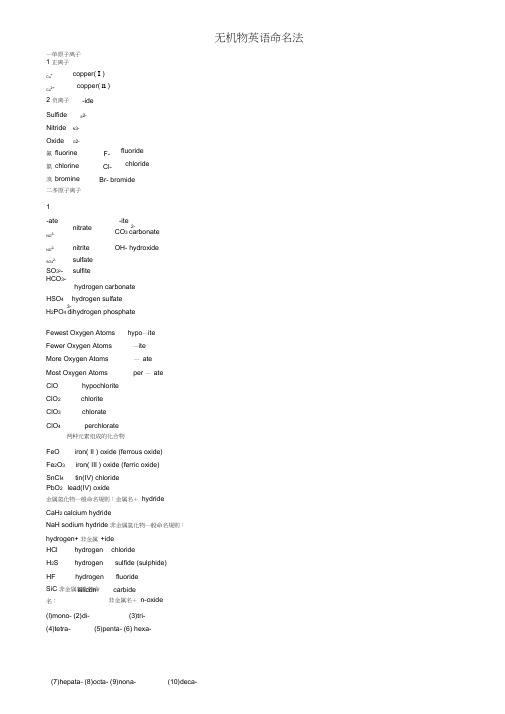
(7)hepata- (8)octa- (9)nona- (10)deca-无机物英语命名法一单原子离子 1 正离子Cu + copper( I )Cu 2+copper( n )2 负离子 -ideSulfide S 2-Nitride N 3-OxideO 2-氟 fluorine F- fluoride 氯 chlorine Cl-chloride溴 bromine Br- bromide二多原子离子1-ate-iteNO3- nitrate2-CO 3 carbonateNO2- nitriteOH- hydroxideSO42-sulfateSO 32- sulfiteHCO 3-hydrogen carbonatehydrogen sulfate3-H 2PO 4 dihydrogen phosphatelead(IV) oxide金属氢化物一般命名规则:金属名+ hydrideCaH 2 calcium hydrideNaH sodium hydride 非金属氢化物一般命名规则: hydrogen+ 非金属 +ideHCl hydrogen chloride H 2Shydrogensulfide (sulphide)HF hydrogen fluoride SiC 非金属氧化物命名: silicon carbide 非金属名+ n-oxide (l)mono- (2)di- (3)tri- (4)tetra- (5)penta- (6) hexa-HSO 4 Fewest Oxygen Atoms hypo —iteFewer Oxygen Atoms More Oxygen Atoms—ite — ateMost Oxygen Atoms per — ateClO hypochlorite ClO 2 chlorite ClO 3 chlorate ClO 4perchlorate两种元素组成的化合物FeO iron( II ) oxide (ferrous oxide) Fe 2O 3 iron( III ) oxide (ferric oxide)SnCl 4 tin(IV) chloride PbO 2CO carbon monoxide CO2 carbon dioxideNO2 nitrogen dioxide N2O4 nitrogen tetraoxideCl2O7 dichlorine heptaoxideClO2 chlorine dioxideSF4 sulfur tetrafluoride SF6 sulfur hexafluorideCrO2 chromium dioxide CrO3 chromium trioxide 四、三种以上元素组成的化合物碱的一般命名规则:金属名(化合价)+hydroxide Sn(0H)2 tin( n ) hydroxideSn(OH)4 tin(IV) hydroxide盐的一般命名规则:金属名(化合价)+酸根名Hg2SO4 mercury( I ) sulfateHgSO4 mercury (n ) sulfateFeSO4 iron(n ) sulfateFe2(SO4)3 iron(山)sulfateNaClO sodium hypochloriteNaClO4 sodium perchlorateKClO 3NaHCO 3含结晶水的hydrate 水合物,unhydrous 无水的,不含水的CuSO4 5H2O copper (II) sulfate pentahydrateCuSO4 unhydrous copper (II) sulfateNaCO31OH2O五无机酸1 不含氧酸hydro- —-ic acideHCl hydrochloric acidHF hydrofluoric acidHBr hydrobromic acidH2S hydrosulfuric acid2 含氧酸-ic正酸把负离子的-ate变为-ic,后边加acidHNO 3 nitric acidH2SO4 sulfuric acidH3PO4-ous亚酸把负离子的-ite变为-ous,后边加acidH2SO3 sulfurous acid3 per- 高某酸hypo- 次某酸HClO 4 perchloric acidHClO hypochlorous acid有机物英语命名法 烷烃的命名普通命名法(中英文)含1〜10个碳的烷烃,称为“某烷”,“某”为词首,采用甲、乙、丙、丁、戊、己、庚、辛、壬、癸表示,从 11个碳开始起用中文数字,词尾为“烷”。
应用化学专业英语 -化合物命名

樊海梅
LOGO
有机化合物的命名
链 烃
饱和烃:烷烃 不饱和烃:烯烃,炔烃 脂环烃 芳香烃
烃
有 机 物
环 烃
卤代烃
烃 的 衍 生 物
醇
含 氧 衍 生 物
酚 醛 酮 羧酸
酯等
烷烃(alkanes) 直链烷烃:英文名称除了含1到4个碳原子以外,其余均用希腊
90 alkane:nonacontane
100 alkane:hectane
含支链烷烃和烷基 烷基:只需要把烷烃的后缀ane换成-yl加在相应烷烃的字 首后 如:CH3- methyl CH3-CH2- ethyl CH3-(CH2)9-CH2 undecyl
还有一些烷基也可以在相应的烃名前加iso-(异)、sec-仲、tert-叔、
和拉丁文的数词加上相应的词尾来命名(烷烃:ane;烯烃: ene;炔 烃:yne),10个碳原子以上的则在数词前加前缀un、do、 tri、 tetra、 penta等。 例如:甲烷:methane 乙烷:ethane 丙烷:propane 丁烷:butane 庚烷:heptane 癸烷:decane 具体来说:11~19:数字前缀-decane 十一烷:undecane 十二烷:dodecane 十三烷:tridecane 十四烷:tetradecane 戊烷:pentane 己烷:hexane 辛烷:octane 壬烷:nonane
丁二烯 butadiene
丁三烯 butatriene
同时还有双键和三键的烷类成为烯炔,命名时烯在前,炔在后, 双键的编号写在前面,三键的定位号写在表示炔烃词尾前
CH3-CH=CH-C ≡ CH
化学专业英语有机化合物中英文命名一ppt课件

烯基alkenyl- alkene
Rule : omit the last letter “e” and add “yl” to the end of the name(去掉最后一个字母“e” , 加上后缀“yl”)
ethenyl 乙烯基) 1-propenyl (丙烯基) trivial names: vinyl, allyl (烯丙基)
to the end of the name(去掉最后一个字母
“e” ,加上后缀“yl”)
1-propynyl(丙炔基), 1-pentynyl(戊炔基)
苯基பைடு நூலகம்
benzene=phene
phenyl(苯基)---benzyl (苯甲基,苄基)
经营者提供商品或者服务有欺诈行为 的,应 当按照 消费者 的要求 增加赔 偿其受 到的损 失,增 加赔偿 的金额 为消费 者购买 商品的 价款或 接受服 务的费 用
C17H36 heptadecane
C4H10 Butane C11H24 Undecane
C18H38 octadecane
C5H12 Pentane C12H26 Dodecane
C19H40 nonadecane
C6H14 Hexane C13H28 Tridecane C7H16 Heptane C14H30 Tetradecane
原则为准则,结合中文特点稍有不同.
经营者提供商品或者服务有欺诈行为 的,应 当按照 消费者 的要求 增加赔 偿其受 到的损 失,增 加赔偿 的金额 为消费 者购买 商品的 价款或 接受服 务的费 用
有机化合物的命名
不含官能团化合物 Nonfunctional Compounds
材料专业英语有机物命名与聚合物命名
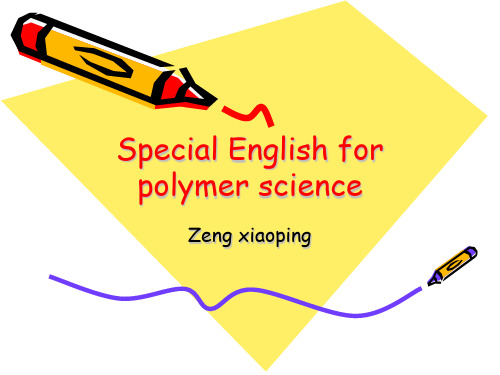
Zeng xiaoping
CnH2n+1 radicals (alkyls)
CH4 methane; “anePentane →pentyl; Heptane→heptyl; Nonane→nonyl;
Propanamide; propionamide
Formamide
Acetamide
聚合物的命名 (′Nomenclature of Polymers)
nomenclature 命名法,术语表 科技论文(尤其涉及公式推导较多的文章)中, 所用代号,公式较多,常在文章最后附录 (Appendix)中加上一节“Nomenclature”, 即“术语表”;
如果单体名是在母体上取代(Substituted parent name),或由多个单词组成或名字特别长, 在“poly”以后加上圆括号
Eg. 3-methyl-1-pentene ⇒poly(3-methyl-1pentene) 3-甲基-1-戊烯 ⇒聚(3-甲基-1-戊烯)
Vinyl chloride ⇒poly(vinyl chloride)
propane →propyl hexane →hexyl octane →octyl decane→decyl
CnH2n radicals
(1) “ane”→
“ylidene” (叉,亚基)
H3C-CH=
Ethylidene (乙叉,亚乙基)
H3C-CH2-CH=
Propylidene(亚丙基)
3-ethyl-2,7-dimethyl-4-propyloctane
Dimethylpentyl <ethyl
有机化学命名专业英语
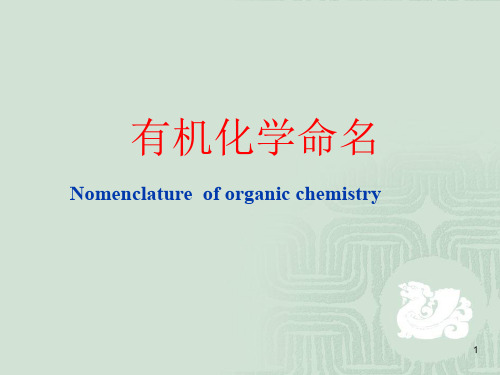
(CH3)2CH-CH-
2-Methylpropyl Isobutyl
CH3-CH2-CH(CH3)- 1-Methylpropyl sec-Butyl
(CH3)3C-
1,1-Dimethylethyl tert-Butyl
CH3-CH2-C(CH3)2- 1,1-Dimethylpropyl tert-pentyl
for example:
31-Alkane
Hentriacontane
32-Alkane 33-Alkane 34-Alkane 35-Alkane 36-Alkane
Dotriacontane Tritriacontane Tetratriacontane pentatriacontane Hexatriacontane
branched-chain hydrocarbon =
n-Radical+alkane
for example:
CCCC
C C
2-M et hy lbut ane
CCC C
2,2-Dimet hy lp rop ane
C C C C C C C 4-Ethyl-2,5-dimethylheptane C CC
CH2=CH2
Ethene
CH2=CHCH2CH2CH3 1-Pentene
CH2=C=CH2
1,2-Propadiene
HC CH
Ethyne
HC C C CH
1,3-Butadiyne
16
Naming unsaturated hydrocarbon
2.1 Unbranched acyclic alkene
1,3-Hexadien-5-yne
化学专业英语有机化合物中英文命名二

Trivial name: glycol(乙二醇), glycerol (丙三醇)…
OH OH CH2 CH2
C C C OH OH
OH HO-C-C-C-OH
glycerol ethylene glycol propylene glycol 1,2-ethanediol 1,2-propanediol 1,2,3-propanetriol
H2 H3C C H2 SH
CH3 SH
1-propanethiol
0-mercaptotoluene
mercapto 含巯基的,含硫氢基的
3、硫醇-Thiols -SH
systematic names: C-C-SH ethanethiol C-C-C-C=C SCH 3 C C-C-C-C-SH 2-methylbutanethiol SH
有机化合物的命名
Nomenclature of Organic Compounds
有机化合物的命名
非官能团化合物 Nonfunctional Compounds
1烃类------(烷烃《 Alkane》烯烃《 Alkene》炔烃 《Alkyne》)
2单环化合物(Monocyclic compounds)
OH C-C-C
OH
isopropyl alcohol
C C-C-C OH
OH
tert-butyl alcohol
2-cyclopenten-1-ol
phenol
2、醇- Alcohols
◆
Alcohols containing more than one OH group Systematic name: suffix: -diol, -triol…
专业英语第三章有机物命名

2,3,3-trimetylhexane
2,3,3-三甲基己烷
4. Cyclic alkanes
Cyclic alkanes are simply prefixed with "cyclo-",
Cyclopropane
Cyclobutane
Cyclopentane
Cyclohexane
bonds
2. Identify the parent functional group, if any, with the highest order of precedence.
3. Identify the side-chains.
4. Identify the remaining functional groups, if any, and name them by the name of their ions .
H3C
CH3
CH
CH2
iso-butyl 异丁基
CH3 H3C C CH3
CH3
CH3 CH2
iso-pentyl 异戊基
CH3 H3C C CH2CH3
sec-butyl 仲丁基
tert-butyl 叔丁基
tert-pentyl 叔戊基
n: normal; sec: secondary (仲); tert: tertiary (叔)
Dopentacontane 五十二烷 Hexapentacontane 五十六烷 Tetrapentacontane 五十四烷
一百烷 hectane 一百三十二烷 dotricontahectane
2. alkyls(烷基)
3.1 Nomenclatures of Organic Compounds Hydrocarbons
- 1、下载文档前请自行甄别文档内容的完整性,平台不提供额外的编辑、内容补充、找答案等附加服务。
- 2、"仅部分预览"的文档,不可在线预览部分如存在完整性等问题,可反馈申请退款(可完整预览的文档不适用该条件!)。
- 3、如文档侵犯您的权益,请联系客服反馈,我们会尽快为您处理(人工客服工作时间:9:00-18:30)。
monoxide
一氧化物
dioxide 二氧化物
sixfold
六倍 electrocardiogram 心电图
1.3 合成 composition
两个或更多的词合成一个词(有时需加连字符) well-known 著名的 carbon steel 碳钢 rust-resistance 防锈 by-product 副产物 makeup 化妆品 cosmetics atomic weight 原子量 periodic table 周期表 acid ionization constant 酸离解常数 activation energy 活化能 rate of a reaction 反应速度
托福
将单词删去一些字母
Yr: year 年 Corp.:corporation 股份公司 Co.Ltd.: Corporation Limited 有限公司 flu: influenza 流行性感冒 maths: mathematics 数学 h./hr: hour 小时 lab: laboratory 实验室 Kilo: kilogram 千克
4. Names of Bases(碱的命名): 元素名称 + hydroxide
* 如果某元素能形成一种以上的阳离子,则使用斯托克 数字(Stock number)来表示其所带电荷(只形成 一种阳离子的不必用). 例:NaOH:sodium hydroxide; KOH:potassium hydroxide
Yield (n.产率)------
yield (v.生成)
Dry (a.干的)------- dry (v.烘干)
1.2 派生 derivation
前、后缀 ---化学科技英语最常用的构词法 alkane [ˈælˌken] “甲烷” methane
如 “烷烃” 词尾变化:
alkene[ˈælˌkin] alkyne['ælkɑɪn] alcohol[ˈælkəhɔ:l] aldehyde['ældəˌhaɪd] alkyl['ælkɪl] “-ene” “烯” “-yne” “炔” “-ol” “醇” “-al” “醛” “-yl” “基”
5. Names of Salts(盐的命名):
不带“ion‖的阳离子名称 + 不带“ion‖的阴离子名称
* 阳离子的电荷数用斯托克数字( Stock number) 来表示(只形成一种阳离子的元素不必用).
例:CuCl:copper(I)chloride;
CuCl2:copper(II)chloride; CuSO4:copper(II)sulfate; KClO4:potassium perchlorate
2. Names of Anions(阴离子的命名)
1) Monatomic anions(单原子阴离子):
元素名称的 词干 + -ide +ion
例:F-:fluoride ion(F:fluorine); Cl-:chloride ion(Cl:chlorine); Br-:bromide ion(Br:bromine); I-:iodide ion(I:iodine)
b. * 酸: 酸根离子中非氧元素名称的词干 + -ic acid c. 亚 * 酸 酸根离子中非氧元素名称的词干 + -ous acid d. 次 * 酸: hypo- + 酸根离子中非氧元素名称的词干 + -ous acid (从a到d含氧原子数依次递减)
偏 * 酸:meta- + 酸根离子中非氧元素名称的词干+ -ic acid 焦 * 酸:pyro- + 酸根离子中非氧元素名称的词干+ -ic acid 例:H2SO4:sulfuric acid; H3PO4:phosphoric acid(P:phosphorus)
* 如果某元素能形成一种以上的阳离子,则使 用斯托克数字( Stock number)来表示其所 带电荷(只形成一种阳离子的不必用)。 2) Polyatomic Cations(多原子阳离子): 原子团名称 + ion 例::Na+:sodium ion;Ag+:silver ion;Ca2+: calcium ion;Al3+:aluminum ion; Fe+:iron(I) ion;Fe2+:iron(II)ion;Fe3+:iron(III)ion; 例:NH4+:ammonium ion
* 氰根(CN-)和氢氧根(OH-)视同单原子阴离子。
CN-:cyanide ion;OH-:hydroxide ion
2) Oxyanions (Oxoanions) (含氧阴离子,又称酸根离子):
非氧元素名称的词干 + -ate + ion(译为“* 酸根离子”) 例:CO32-:carbonate ion(C:carbon) SO42-:sulfate ion(S:sulfur) SO32-:sulfite ion NO3-:nitrate ion(N:nitrogen) NO2-:nitrite ion ClO-:hypochlorite ion ClO2-:chlorite ion ClO3-:chlorate ion ClO4-:perchlorate ion PO3-(偏磷酸根):metaphosphate ion
1.4 压缩法 shortening
只取词头字母: CET: College English Test 大学英语 TOEFL: Test of English as a Foreign Language ppm: part(s) per million 百万分之一 m.p. : melting point 熔点 rpm(r/m): revolution per minute 转/分钟
hypo- + 非氧元素名称的词干 +ite + ion (从a到d含氧原子数依次递减)
偏 * 酸根离子:meta- +非氧元素名称的词干 + - ate + ion 焦 * 酸根离子:pyro- +非氧元素名称的词干 + - ate + ion
3) Anions containing hydrogen(含氢阴离子) hydrogen + 去掉氢的离子名称
Nomenclature of compound
1 科技英语构词特点
一是外来语多(希腊语、拉丁语) 二是构词方法多
常规的构词法——转化、派生、合成法
其它:压缩法、混成法、符号法和字母象形法
1.1 转化 conversion
Water (n.水)-----
water (v.浇水)
Charge (n.电荷)----- charge (v.充电)
* 如果某元素能形成一种以上的含氧阴离子,则按以下规则: a. 高(过)* 酸根离子: per- + 非氧元素名称的词干 + -ate + ion b. * 酸根离子:非氧元素名称的词干 + -ate + ion c. 亚 * 酸根离子:非氧元素名称的词干 + -ite + ion
d. 次 * 酸根离子:
Nomenclature of organic compound
1. Nomenclature of Hydrocarbons:(烃类命名法) 1)Aliphatic Hydrocarbons(Fatty Hydrocarbons,脂肪烃) a. Number Prefix(数字前缀): i). 总碳数≤10时(total C no. ≤10):
1. 甲: meth-; 2. 乙: eth-; 3. 丙: prop-; 4. 丁: buta-; 5. 戊: penta-; 6. 己: hexa-; 7.庚: hepta-; 8. 辛: octa-; 9. 壬: nona-; 10. 癸: deca-. 11. 半, 1/2: hemi-, semi-; 12. 单, 一: mono-, uni-; 13. 3/2: sesqui-; 14. 双, 两: di-, bi-, bis-.
调制器+解调器→调制解调器
1.6 字母形象法
用以表示事物的外形,产品的型号、牌号等
U-pipe: U形管 X-ray: X射线 V-belt: V带
Nomenclature of inorganic compound
1. Names of Cations(阳离子的命名)
1) Monatomic Cations(单原子阳离子): 元素名称 + ion
b.
烷烃(alkane)命名:
数字头 + -ane(以a结尾的数字头直接加-ne)
Ethane [ˈɛθˌen]
例: 甲烷: methane; 庚烷: heptane; 癸烷: decane; 十三烷: tridecane; 十四烷: tetradecane; 十五烷: pentadecane; 二十烷 : (e)icosane; 二十一烷 : heneicosane; 二 十 二 烷 : docosane; 三 十 烷 : triacontane; 四 十 烷 : tetracontane; 五 十 烷 : pentacontane; 六十烷 : hexacontane; 七十烷 : heptacontane; 八 十 烷 : octacontane; 九 十 烷 : nonacontane; 一百烷: empirecontane.
7. Names of Hydrates(水合物的命名):
非水化合物名称 + 表示结晶水个数的希腊数字前缀 + hydrate * 常用数字前缀 :1. mono-; 2. bi-; 3. tri-;
